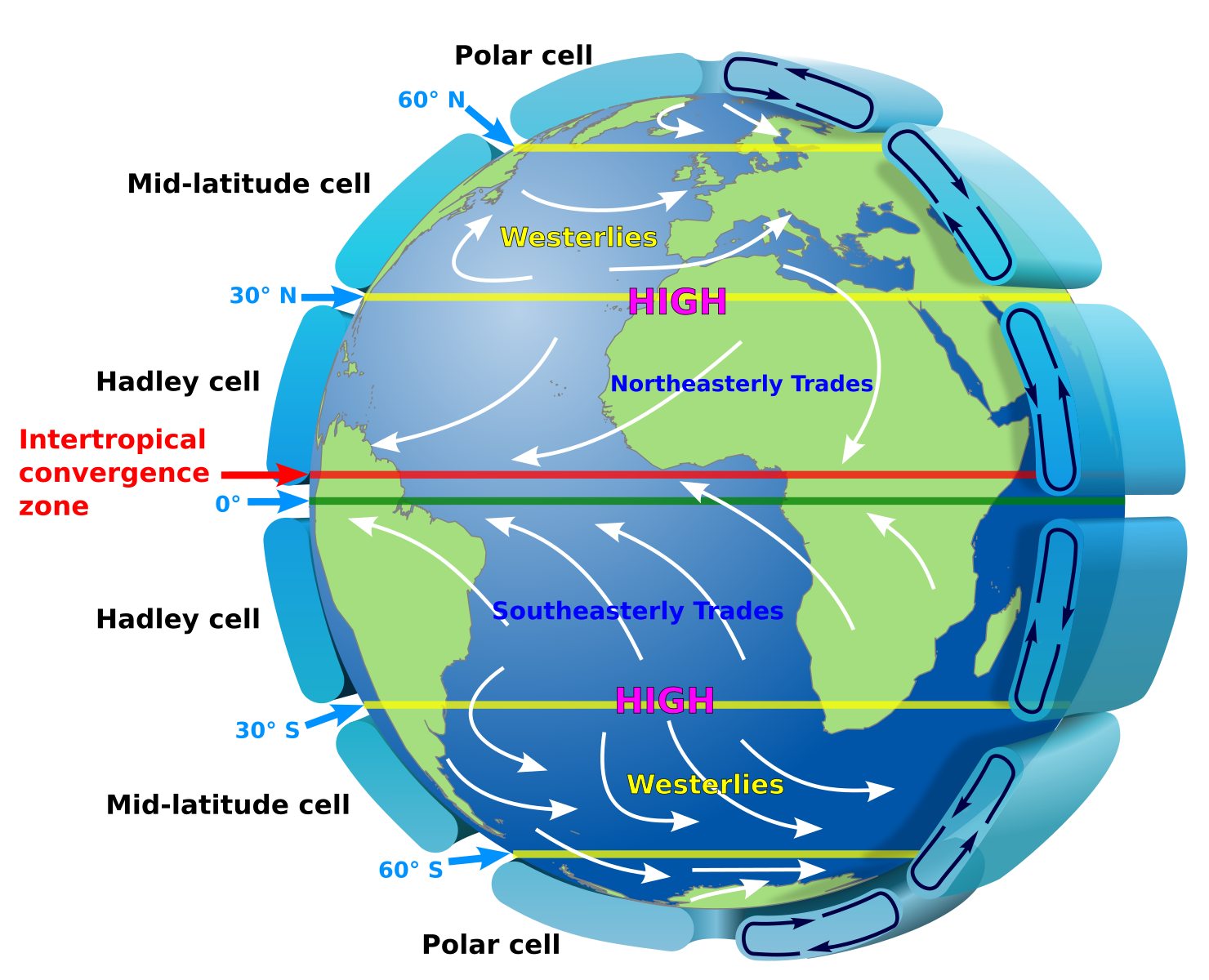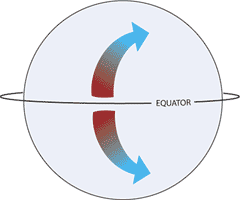IB Syllabus focus:
‘Differential heating drives Hadley, Ferrel and Polar cells that move heat poleward, moderating equator–pole temperature contrasts.’
The tricellular circulation model explains how heat is redistributed from the equator toward the poles. This global atmospheric system balances uneven heating, reducing temperature contrasts across latitudes.
Structure of the Tricellular Circulation
The circulation system is divided into three major convection cells in each hemisphere. Together, these cells form the Hadley cell, Ferrel cell, and Polar cell, which work interactively to move energy.

Simplified global atmospheric circulation showing the Hadley, Ferrel and Polar cells in each hemisphere, with rising and sinking branches that transport heat from low to high latitudes. The layout highlights subtropical highs, subpolar lows and the general poleward redistribution of energy. Minor labels beyond the syllabus (e.g., jet-stream hints) may appear but remain supportive rather than essential. Source.
Hadley Cell
The Hadley cell is located between the equator (0°) and about 30° latitude.
Intense solar heating at the equator warms the surface and air.
Warm air becomes less dense and rises, creating a low-pressure zone at the equator.
As the air rises, it cools, condenses, and forms cumulonimbus clouds and heavy rainfall (e.g., tropical rainforests).
The upper tropospheric air spreads poleward before sinking around 30°, producing high-pressure zones and arid conditions (e.g., deserts).
The surface return flow completes the cell, with trade winds blowing towards the equator.
Trade Winds: Steady surface winds blowing from the subtropics toward the equator, curving westward due to Earth’s rotation.
Ferrel Cell
The Ferrel cell lies between 30° and 60° latitude.
It operates as a secondary circulation system, indirectly driven by the Hadley and Polar cells.
Air at 30° latitude flows poleward at the surface.
At around 60°, it converges with cold air from the poles, forcing it upwards.
This rising air creates low-pressure zones with frequent storms and precipitation (e.g., temperate regions).
The upper-level air returns equatorward, closing the circulation.
Polar Cell
The Polar cell spans from 60° to 90° latitude.
Cold, dense air sinks at the poles, generating high pressure.
Surface winds move toward 60° latitude, where they meet warmer air masses from lower latitudes.
This convergence forms the polar front, a boundary zone of unstable weather.
Rising air at 60° then moves poleward aloft, completing the cell.
Polar Front: The meeting zone between cold polar air and warmer mid-latitude air, often associated with storms and cyclonic systems.
Role of Differential Heating
The tricellular circulation arises due to differential heating of Earth’s surface:
The equator receives concentrated solar radiation, leading to higher surface temperatures.
Toward the poles, the Sun’s energy is spread over a larger area and passes through more atmosphere, producing cooler conditions.
This uneven heating drives convection currents that redistribute thermal energy poleward.
The Coriolis Effect and Wind Patterns
Earth’s rotation deflects moving air, a process known as the Coriolis effect.
In the Northern Hemisphere, moving air is deflected to the right.
In the Southern Hemisphere, moving air is deflected to the left.
This deflection shapes global wind belts:
Trade winds (easterlies in the tropics)
Westerlies (prevailing mid-latitude winds)
Polar easterlies (cold winds near the poles)

Illustration of the Coriolis effect showing the deflection of moving air to the right in the Northern Hemisphere and to the left in the Southern Hemisphere. This mechanism helps establish the major surface wind belts associated with the three-cell circulation. The figure includes brief context about a non-rotating Earth for comparison, which exceeds the syllabus slightly but clarifies why three cells form. Source.
Coriolis Effect: The deflection of moving air or water due to Earth’s rotation, influencing global wind and current patterns.
These winds interact with the three circulation cells, further aiding global heat transfer.
Moderating Temperature Contrasts
The combined action of the Hadley, Ferrel, and Polar cells redistributes energy:
Warm air and heat are transported poleward.
Cooler air and conditions extend equatorward.
This reduces the stark temperature gradient between equator and poles, stabilising Earth’s climate system.
Key Processes in Redistribution
Hadley cell transfers heat from the equator to subtropics.
Ferrel cell mixes tropical and polar air, spreading heat across mid-latitudes.
Polar cell drives limited poleward circulation but is crucial for the polar front system.
Together, these interactions moderate extreme contrasts, creating climate zones (tropics, deserts, temperate, polar).
Interaction with Weather and Climate
The tricellular system shapes global weather patterns:
Equatorial regions: Heavy rainfall, tropical climates.
Subtropical zones: Dry, desert conditions.
Mid-latitudes: Variable climate with storms, seasonal change.
Polar regions: Cold, stable high-pressure conditions.
Summary of Significance
The tricellular circulation is a core atmospheric system that links solar radiation, differential heating, and Earth’s rotation to produce predictable climate zones and redistribute heat globally. Without it, equatorial regions would overheat while polar regions would remain excessively cold, destabilising life-supporting conditions.
FAQ
At about 30° latitude, the air that rose at the equator descends. This sinking air is dry because much of its moisture condensed and fell as rain near the equator.
As it descends, it warms, increasing its capacity to hold water vapour. This creates high-pressure conditions and little rainfall, which is why many of the world’s largest deserts, such as the Sahara and Kalahari, occur in these zones.
Jet streams are narrow bands of fast-moving air formed at the boundaries of circulation cells.
The tropical jet stream occurs at the boundary between the Hadley and Ferrel cells.
The polar jet stream forms where the Ferrel and Polar cells meet.
Differences in temperature gradients and pressure contrasts at these boundaries determine their speed and strength, with polar jets often being faster due to sharper contrasts.
Earth’s tilt causes the Sun’s overhead position to shift north and south during the year.
In summer, the Hadley cell expands poleward, pushing the subtropical high-pressure zones further from the equator.
In winter, the cells contract equatorward, moving pressure belts and wind patterns accordingly.
This seasonal migration strongly influences monsoons, tropical rainfall, and subtropical dry zones.
Surface winds generated by the tricellular circulation help drive ocean currents.
Trade winds push equatorial surface water westward, creating warm currents such as the Pacific’s equatorial current.
Westerlies move surface waters eastward in the mid-latitudes, forming strong boundary currents like the Gulf Stream.
These interactions redistribute heat between ocean and atmosphere, further balancing global temperature contrasts.
Unlike the Hadley and Polar cells, which are directly driven by rising and sinking air due to temperature differences, the Ferrel cell is indirectly driven.
It acts as a “gear” between the other two cells, influenced by their circulation and by mid-latitude cyclones. Because of this indirect nature, its position and intensity fluctuate, making the Ferrel cell more variable and less stable than the Hadley or Polar cells.
Practice Questions
Question 1 (2 marks)
Identify two atmospheric circulation cells in the tricellular model and state the approximate latitudinal range of one of them.
Mark Scheme:
1 mark for correctly naming a cell (Hadley / Ferrel / Polar).
1 mark for giving a correct latitudinal range for any one cell:
Hadley cell: 0°–30°
Ferrel cell: 30°–60°
Polar cell: 60°–90°
Question 2 (5 marks)
Explain how differential heating and the Coriolis effect interact to produce global wind patterns within the tricellular circulation system.
Mark Scheme:
1 mark: States that solar radiation heats the equator more than the poles, creating temperature and pressure differences.
1 mark: Explains that rising warm air at the equator and sinking cool air at higher latitudes create convection currents.
1 mark: Describes how the Coriolis effect deflects moving air to the right in the Northern Hemisphere and to the left in the Southern Hemisphere.
1 mark: Links the deflection to the creation of specific wind belts (e.g., trade winds, westerlies, polar easterlies).
1 mark: Demonstrates understanding that the interaction between heating and Coriolis shapes the three-cell structure and redistributes heat poleward.

